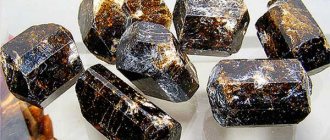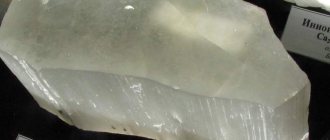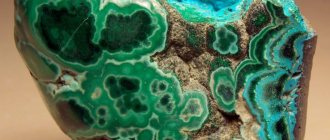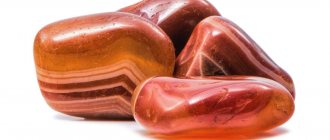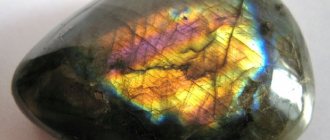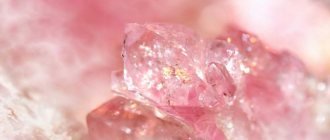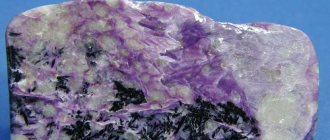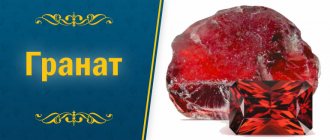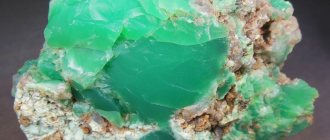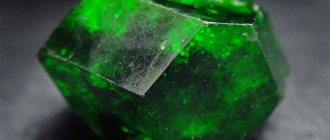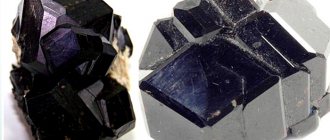Few people know that garnet is not a single stone. This is a whole group of minerals that differ in their shade. Sometimes the color of stones can be so deep and piercing that it seems as if it cannot be true. One of these gems is pyrope, which has not only an attractive appearance, but also special energy properties. The vibrations of natural pyrope help its owner overcome difficult periods in life and cure certain diseases.
Place of Birth
Pyrope is a stone of igneous origin; its formation often occurs next to diamond, or the latter contains an admixture of pyrope.
Large deposits
— Advertising —
The largest deposits of the mineral were discovered on the island of Sri Lanka, in the countries of South America, in the USA and the Czech Republic. In addition, bright purple pyropes, called rhodolites, were found near the Tanzania-Kenya border.
Residents of India and Brazil developed mines of purple pyropes, which in their hue are similar to grape juice and were called grape pyropes.
Deposits in Russia
Pyrope is also mined in Russia (Yakutia, Khakassia, Irkutsk region).
The highest quality jewelry samples of pyropes are usually found in the Czech Republic (Bohemian garnet or Bohemian ruby) and on the island of Sri Lanka. These crystals often contain rutile as inclusions and exhibit cat's eye or star effects when processed.
Artificial acquisition
Obtained from a mixture of kaolinite, Si02, MgO and MgCl2 at a temperature of 900° and a pressure of 30,000 atm., from a mixture of the corresponding oxides when heated to 1600° and a pressure of 50-60 kbar. Stable at pressure 15-40 kbar and temperature 1000-1750°. At lower pressure it decomposes into Al-enstatite, sapphirine and sillimanite.
Diagnostic signs
Diagnostic signs
. Macroscopically, they are easily recognized by the characteristic appearance of the crystals, greasy luster, high hardness and relatively high specific gravity. Under a microscope, it differs from staurolite in isotropy, and from almandine in its refractive index.
Associated minerals diamond, olivine
Story
— Advertising —
origin of name
The term "pyrope" is of Greek origin and is translated as "like fire." There was a legend that it was the fiery red pyrope that lit the way for Noah’s Ark during the flood.
In ancient Rome
In ancient Rome, the mineral was called carbuncle (from “carbunculus”, meaning “smoldering coal”). It was considered a symbol of the god of war, Mars, and all warriors carried it with them. According to legends, if you drink from a bowl of pyrope before a battle, you can become a winner in any battle.
In Russia
In Rus', pyrope also had its own names: becheta, venisa, worms, yaghuts.
Because of their external resemblance, jewelers often call pyropes rubies, indicating their region of origin (Bohemian, Amazonian).
Physico-chemical characteristics
Pyrope is a member of the pomegranate family. In terms of its chemical composition, it is quartz with an admixture of magnesium and aluminum, that is, magnesium-aluminum orthosilicate. The color of the stone is associated with the presence of iron, manganese and chromium compounds in its composition. In their absence, pyrope remains colorless. Some gemstone samples may contain rutile, which leads to interesting “star shine” or “cat’s eye” effects.
Magic properties
Residents of India and Sri Lanka believed that pyrope is a very powerful and energetic stone, and therefore only people who are strong in spirit and love power can cope with it and conquer it.
The magical abilities of this gem have always been associated with blood and flame due to its external similarity. For this reason, the stone is considered equally responsive to both good and evil; as an amulet it is suitable for both a lover and a warrior. But it will not be possible to re-educate pyrope. If he has already taken part in bloody events, he will incite his master to further use force in any situation. But pyrope, which was owned by a kind and good person, on the contrary, will absorb love and cordiality, and will become the personification of peacefulness.
Health Importance
The unique healing properties of pomegranate were known back in ancient India. The sages of the past used the stone to prevent or treat diseases associated with the blood, circulatory system and more.
A pyrope talisman will help a pregnant woman carry and give birth to a healthy baby.
Medicinal properties of pyrope:
- strengthens the cardiovascular system;
- improves immunity;
- helps cleanse the respiratory system;
- normalizes blood pressure;
- relieves inflammation.
Since pyrope has the property of calming pain, it was actively used for abrasions, bruises and wounds. Simply hanging a mineral around your neck on a cord is not enough. Then the force of influence will be much less. The maximum effect will be if you apply the crystal to the location of the pain.
There was a tradition of giving pyrope to pregnant women. It was believed that such a talisman supported the strength of the expectant mother and helped reduce pain during childbirth.
The fire-like gem is also prescribed for preventive purposes. However, when trying to strengthen the body in this way, one must not lose vigilance. This is especially true for public people, as well as those who lead an active lifestyle.
Pyrope contains a considerable amount of energy and easily shares it with the owner. But an excess of energy, like its lack, can also cause harm. Therefore, it is better not to abuse the help of the amulet.
Medicinal properties
The healing qualities of pyrope are associated with the circulatory and hematopoietic system of the body.
The mineral activates blood circulation, increases vascular permeability, thereby improving tissue metabolism processes. With daily visual and tactile communication with pyrope, people recover faster after long-term illnesses, injuries, and operations. Pyrope, colored pink, helps in the treatment of mental illness. It normalizes the functioning of the nervous system, has a calming effect, gives a good mood and a positive outlook.
For healthy people, pyrope is recommended as a preventive measure. It gently corrects the psychological state of its owner and prevents the occurrence of serious problems in the emotional sphere.
Name compatibility
If the stone also corresponds to the name of its owner, it brings additional benefits. However, it is not so much the names themselves that are important, but the letters and sounds in them. The most suitable names for pyropes are:
- Maria;
- Lyudmila;
- Anton;
- Andrey.
The hard energy of crystals is softened by gentle female names with a predominance of vowel sounds, allowing the Mars mineral to show only positive qualities. For such names, pyrope becomes a talisman in love and business. Male names with a tough sound can make the owner invulnerable to the destructive power of the energy of the fire stone and help to resist the aggressiveness that the mineral transmits to the owner.
Applications
Pyrope, along with other garnets, is very easy to process.
In addition, it is widely distributed and therefore an inexpensive gem. The best examples for use in jewelry are Czech stones, the so-called “Bohemian garnets.” She began making jewelry with them back in the 10th-11th centuries. In addition, some pyropes are very similar in color to rubies. Jewelers came up with the idea of calling them Arizona, Cape, and Bohemian rubies and at the same time raising their prices.
Pyrope can also be transparent, but in this case they are not used in jewelry, but are used as an abrasive material.
How to spot a fake and avoid scammers
Pyrope is a relatively inexpensive stone, so it is rarely counterfeited. More often this mineral is passed off as more valuable rubies. You should buy jewelry in jewelry stores. Here, products are sold with all the necessary documents, which indicate the country of origin and all the characteristics of the stone.
More often, jewelry with synthetic pyrope, as well as glass or plastic fakes, can be purchased at various fairs and souvenir shops.
To identify a fake stone, you need to:
- Study the documents. If they are not present or the seller is unwilling to provide them, this indicates that the crystal is not genuine.
- Pay attention to the size of the stone. Natural samples are often small. If the specimen is large, it is of synthetic origin.
- Place the crystal against your hand. If it heats up quickly, it is not real pyrope, but a glass or plastic fake.
- Examine the crystal under a magnifying glass. The synthetic sample has a uniform color, but the natural stone does not.
Colors and shades
Czech pyropes are painted in a luxurious dark red color.
Less common for them are shades of orange, purple, pink, blood red or fiery red. There are pyropes that have a cherry tint or the color of red wine. Such specimens often receive romantic names, for example, “the glow of extinguished coals in the hearth” or “the petal of a pomegranate flower.” It is because of this color scheme that pyropes are often confused with rubies, tourmalines and almandines.
How to care for stone
As a durable stone, pyrope is easy to care for.
To clean it, a soap solution is suitable, in which the product is immersed for half an hour, after which it is cleaned with a soft brush. The stone is then rinsed with cool running water and polished with a dry cloth. In addition, a saline solution is used for these purposes, which is prepared from one teaspoon of salt per liter of water. The product with pyrope is left in it for 8-10 hours, after which it is washed with running water and wiped dry. To restore pyrope to its beautiful shine, the stone can be wiped with a cloth soaked in alcohol.
Mineral Change
It turns into a green substance - “kelyphite” - kelyphite (Shrauf, 1882), which is a mixture of fibrous amphibole, feldspar, pyroxene, spinel, chlorite, biotite, calcite and forms crusts on pyrope grains. The most intense kelyfitization manifested itself in eclogites. According to Mathes, the formation of kelyphite rings around pyrope is not the result of hysterogenic destruction. According to Yoder, kelyphite is formed by pyrope in the presence of H2O at a temperature of 600° and a pressure of about 30,000 psi. There is also undoubtedly the formation of chlorite from pyrope. When rhodolite changed with hypersthene, anthophyllite and biotite were formed.
Pyrope and zodiac sign
Pyrope is most suitable for zodiac signs representing the fire element.
It is considered an ideal talisman for Leo, it will bring him good luck, help him manage and influence the people around him. Sagittarius will use this stone to reveal all their talents. Pyrope will also get along well with Scorpios. This gem is not recommended for signs that belong to the element of Water (Pisces, Cancer, Scorpio), as water blurs its magical properties.
Rules of care
Jewelry containing pyrope needs to be wiped with a flannel cloth from time to time. It is recommended to wash the gem twice every 6 months in warm, soapy water and saline solution. Products must be stored in a specialized container, preferably without foreign jewelry.
It is important to handle pyrope carefully, otherwise the mineral may crack after a certain time.
The pyrope gemstone can have a positive and negative effect on a person. The effect on the body depends on how long a person wears the gem on the body. You also need to pay attention to the effect the mineral has on the zodiac sign. If a stone helped one person perfectly, this does not mean that pyrope will be useful to another.
Interesting Facts
- Deposits of pyrope in the Czech Republic were discovered during the Middle Ages. At the same time, they began to make jewelry from it and called the stone “Czech garnet” for its rich red color and bloody reflections. The 19th century is considered the peak of stone mining.
- In the north of Bohemia, in the town of Trebnitz, a museum of pyrope of Czech origin has been created. The world's largest specimen of the stone, the size of a pigeon's egg and weighing 468.5 carats, is stored there.
- There are many synonyms for pyrope: Colorado rubies, Arizona rubies, California rubies, American rubies, Cape rubies. Along with other red stones, it was called carbuncle. And in Rus', until the 14th century, pyropes were part of the “lal” group of stones with all other red minerals.
Where is the gem used?
The stone has found application in jewelry, collecting and industry.
Jewelers make from it a full range of jewelry in gold or silver:
- The companions of the main carbuncle stone are often colorless diamonds or cubic zirconia.
- Products made of pyrope in gold with diamonds are an attribute of rulers, status, and accomplished persons. Or those trying to present themselves as such. They are given as recognition of a person as a leader or a declaration of passionate love.
- Czech pyropes have a special place among jewelers. The technology of their processing, the details of which are not disclosed, eliminates the presence of impurities and spotting in the structure. And the surface of the stone seems to be on fire. Only special equipment can distinguish between ruby and pyrope from Bohemia. The price of such specimens is comparable to precious stones.
Jewelry with local pyropes has been the regalia of the rulers of the Czech Republic for centuries. Today it is a luxury brand and a national treasure of the country.
Substandard jewelry is obtained by industrialists as abrasive raw materials.
Earrings with pyrope
Museum workers and mineral collectors are hunting for diamond intergrowths with these red garnets.
